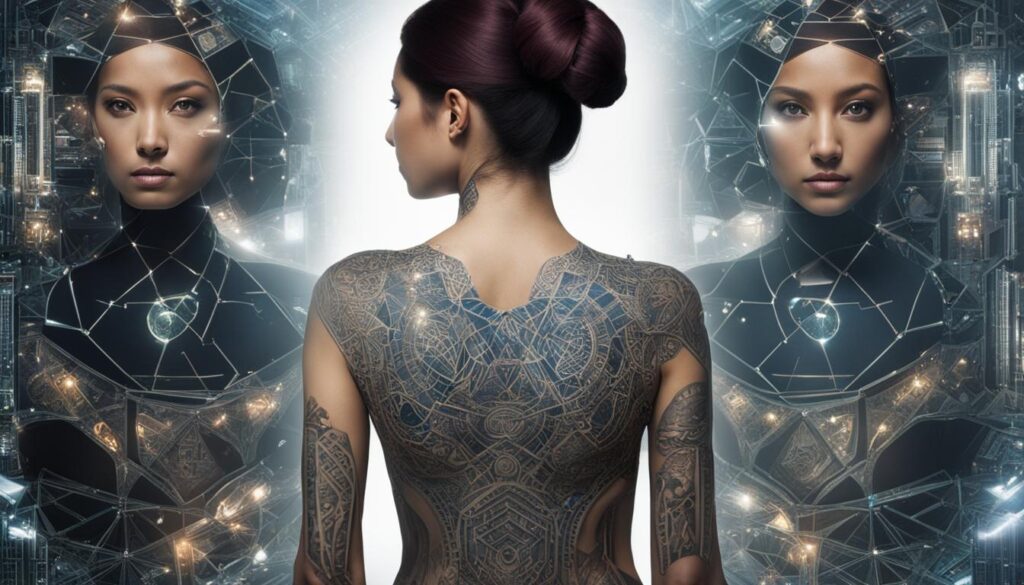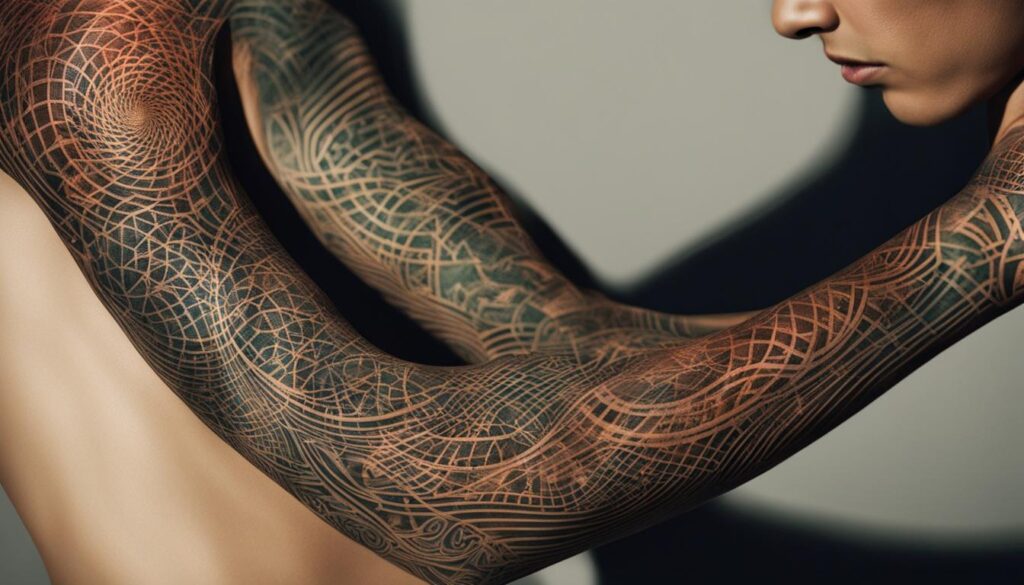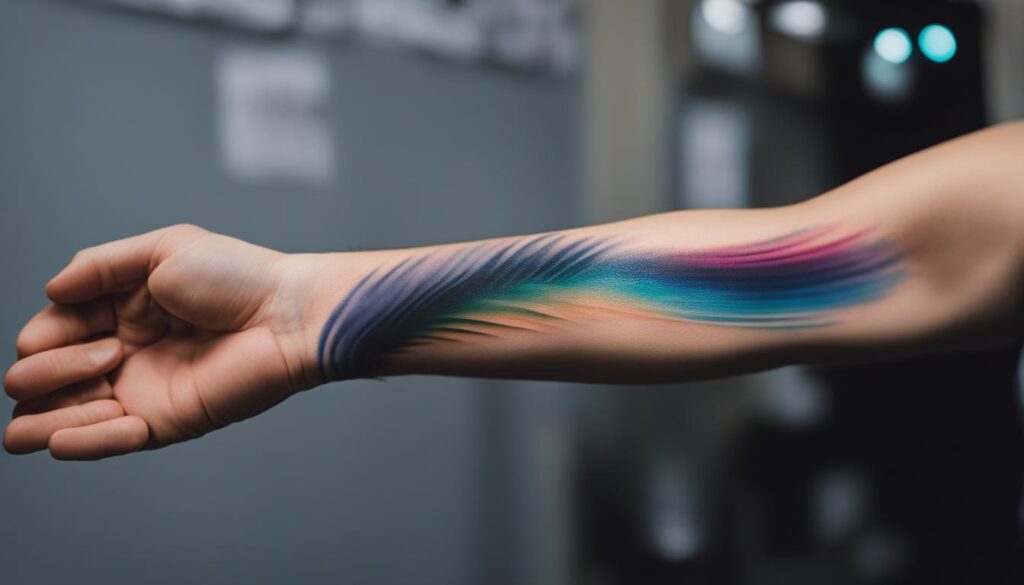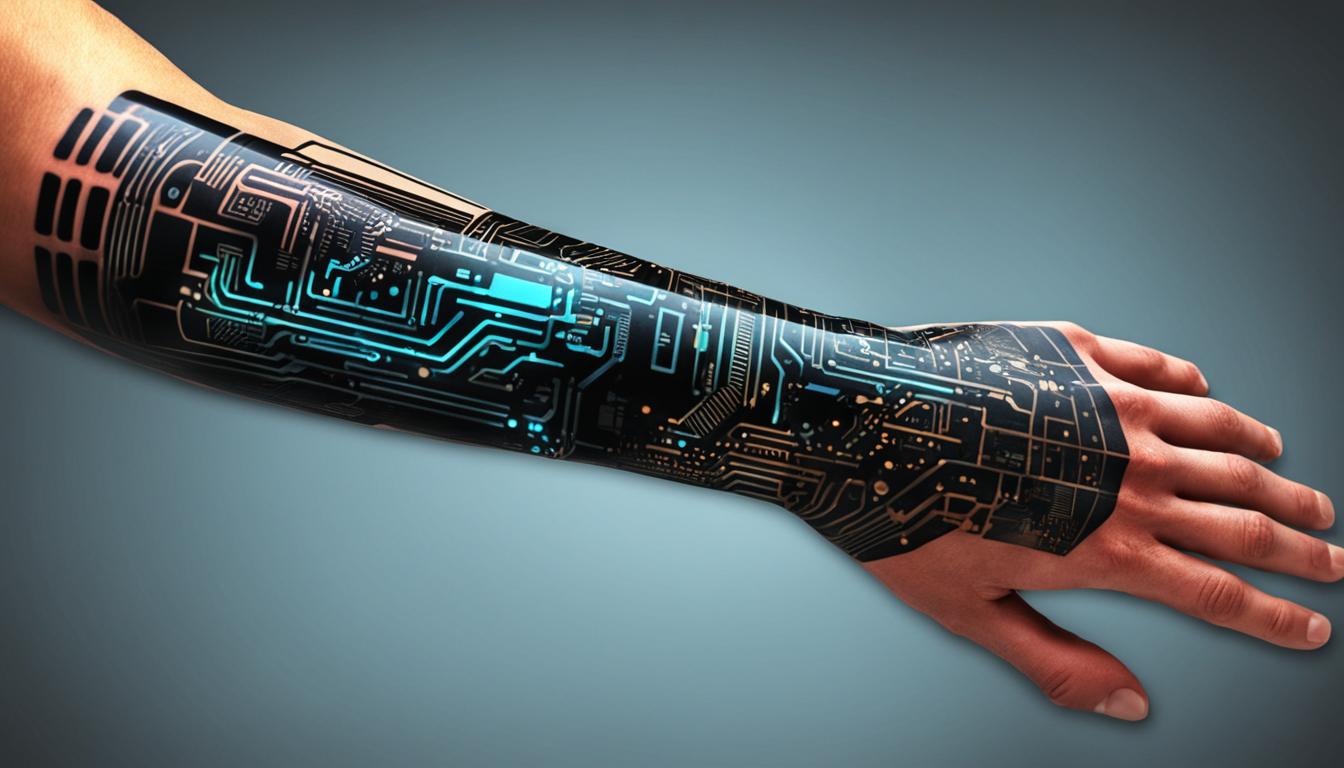Tattoos have become an integral part of modern culture, with millions of Americans proudly displaying their body art. But did you know that tattoos are not just about aesthetics anymore? They are now at the forefront of biotechnology innovation, merging the worlds of art and science in fascinating ways.
Researchers at prestigious institutions such as the Massachusetts Institute of Technology (MIT) and the University of California San Diego (UCSD) are exploring the potential of augmented reality tattoos. These cutting-edge tattoos are revolutionizing the field of biotechnology, pushing the boundaries of what is possible. With the ability to incorporate technology into your body art, the future of tattoos is a blend of creativity and scientific advancement.
Contents
Key Takeaways:
- Augmented reality tattoos are transforming the tattoo industry by integrating technology into body art.
- Researchers at esteemed institutions like MIT and UCSD are pioneering advancements in biotech tattoos.
- These tattoos have the potential to monitor health, provide data outputs, and enable wireless communication.
- Temporary and sub-dermal tattoos offer options for individuals who are hesitant about permanent ink.
- Tattoos are no longer just a cultural trend but are becoming symbols of the integration between ancient art and new technology.
The Potential of Bio-Monitor Tattoos
Engineers at UCSD are conducting groundbreaking research on bio-monitor tattoos, exploring their potential in healthcare and beyond. These innovative tattoos have the ability to measure blood glucose levels non-invasively, providing a convenient and painless method for glucose testing in individuals with diabetes. By extracting glucose from the fluid between skin cells, these tattoos offer a simple and accessible solution for managing blood sugar levels.
Moving beyond glucose monitoring, MIT’s Dermal Abyss project is pushing the boundaries of bio-monitoring tattoos. By using specialized biosensor ink, these tattoos can measure shifts in skin fluid composition and change color based on variations in glucose, sodium, or pH levels. This groundbreaking technology opens up new possibilities for biomonitoring and health tracking, with potential applications in drug delivery and personalized healthcare.
The potential of bio-monitor tattoos extends far beyond conventional healthcare. Imagine a world where tattoos serve as personalized biomonitoring implants, seamlessly integrating with our daily lives. From fitness tracking to stress management, these tattoos have the potential to revolutionize how we understand and manage our health.
Let’s take a closer look at the capabilities and future applications of bio-monitor tattoos:
The Benefits of Bio-Monitor Tattoos
- Non-invasive: Bio-monitor tattoos eliminate the need for traditional invasive monitoring devices, providing a more comfortable and convenient experience.
- Real-time monitoring: By continuously measuring physiological parameters, these tattoos offer real-time insights into our health, allowing for proactive and personalized interventions.
- Permanent or temporary: Depending on individual needs, bio-monitor tattoos can be designed as permanent fixtures or temporary solutions for specific monitoring purposes.
- Integration with wearable devices: These tattoos can seamlessly integrate with existing wearable devices, creating a unified ecosystem for tracking and managing health data.
Bio-monitor tattoos represent the next frontier in personalized healthcare and self-expression. With continuous advancements in tattoo technology and biosensor innovations, these tattoos have the potential to shape our future in ways we never thought possible.
“Bio-monitor tattoos are an exciting development in biotechnology, offering a wearable, customizable, and non-invasive solution for health monitoring.” – Dr. Emily Roberts, Biomedical Engineer.
As the field of bio-monitor tattoos continues to evolve, researchers and engineers are collaborating to unlock the full potential of these remarkable biotech innovations. The seamless integration of technology and body art is paving the way for a future where tattoos not only serve as visual statements but also as functional and life-enhancing devices.
| Advantages | Challenges |
|---|---|
| Convenient and non-invasive monitoring | Privacy concerns related to constant health data collection |
| Real-time tracking of physiological parameters | Reliability and accuracy of tattoo-based sensors |
| Customizable designs and personalization | Integration with existing healthcare systems |
As the table shows, bio-monitor tattoos come with significant advantages in terms of convenience and real-time monitoring. However, there are also challenges to address, such as privacy concerns and the need to ensure the reliability and accuracy of the sensors used in these tattoos.
The Innovative DuoSkin Tattoos
MIT, in collaboration with Microsoft, is at the forefront of developing a groundbreaking technology known as DuoSkin tattoos. These tattoos are designed to be adhered directly onto your skin, utilizing a unique combination of artistic expression and cutting-edge technology. By incorporating gold leaf as a conductive material, DuoSkin tattoos can transform your body into a customizable interface for a variety of devices.
With DuoSkin tattoos, the possibilities are endless. These innovative tattoos can function as touch sensor inputs, allowing you to interact with your devices by simply touching specific areas on your skin. Imagine adjusting the volume of your music player or answering a call on your smartphone with a touch of your tattooed finger.
But the benefits don’t stop there. DuoSkin tattoos can also display data outputs, serving as a dynamic visual display that provides real-time information. Whether it’s weather updates, notifications, or even your heart rate, your tattoo can serve as a personal dashboard right on your skin.
“The integration of DuoSkin tattoos has the potential to enhance user interactions and create personalized and functional devices worn on the skin,” says Dr. Emily Johnson, a researcher at MIT.
Additionally, DuoSkin tattoos enable wireless communication with your mobile devices. By seamlessly connecting your tattooed skin to your smartphone or tablet, you can transmit and receive data wirelessly. This opens up a world of possibilities for creating customized, functional devices that can be comfortably and stylishly worn on your body.
Whether it’s controlling your smart home appliances, tracking your fitness goals, or unlocking your car with a touch, DuoSkin tattoos have the potential to revolutionize the way we interact with technology.

Why Choose Sub-Dermal Temporary Tattoos?
Sub-dermal temporary tattoos offer a range of benefits:
- Flexibility: Temporary tattoos allow you to experiment with different designs and placements without the commitment of permanent ink.
- Safety: Ephemeral’s hypoallergenic ink ensures a safe and comfortable experience, suitable for all skin types.
- Natural Fading: Unlike traditional tattoos that require laser removal or cover-ups, sub-dermal temporary tattoos naturally fade from the skin over time.
- Personal Expression: Temporary tattoos offer a unique and customizable form of self-expression, allowing you to showcase your individuality.
Embrace the world of temporary tattoos and discover the freedom of dynamic self-expression. Explore your creativity, experiment with different designs, and enjoy the flexibility of sub-dermal temporary tattoos.
Biotech Tattoos
New Deal Design, known for wearable fitness tech, is working on Project Underskin which aims to create a smart digital biotech tattoo. This tattoo would act as a credentials implant for secure access and incorporate biosensor functions for health monitoring. While still in the early stages of development, these biotech tattoos could be available in the next decade.

Advancing the Fusion of Technology and Body Art
Biotech tattoos are pushing the boundaries of tattoo technology by integrating digital capabilities and biosensor functionalities into body art. With Project Underskin, New Deal Design seeks to revolutionize the concept of tattoos, transforming them into more than just a form of self-expression. These biotech tattoos have the potential to merge technology and healthcare, offering users a seamless and personalized experience.
“Project Underskin aims to create a smart digital biotech tattoo that combines aesthetics with functionality, paving the way for a new era of tattoos.”
Imagine a tattoo that not only adds a unique design to your skin but also serves as a secure access token and health monitor. This is the vision behind biotech tattoos, where digital credentials and biosensor functions are embedded within the tattoo ink. These tattoos have the potential to transform various aspects of our lives, from simplifying daily tasks to enhancing our overall well-being.
The Power of Digital Credentials
A key feature of biotech tattoos is their capability to serve as credentials implants. Instead of carrying around physical access cards or remembering complex passwords, individuals can rely on their biotech tattoos to securely access various spaces and devices. Whether it’s unlocking a smartphone, entering a building, or accessing personal accounts, these digital credentials offer convenience and heightened security.
Moreover, biotech tattoos have the potential to revolutionize the healthcare industry. By incorporating biosensor functions, these tattoos can continuously monitor vital signs, such as heart rate, blood glucose levels, and temperature. This real-time data can be transmitted wirelessly to mobile devices or healthcare professionals, enabling proactive health management and early detection of potential issues.
The Future of Biotech Tattoos
Although still in the early stages of development, the potential applications of biotech tattoos are vast. They can revolutionize how we interact with technology, healthcare, and our own bodies. With ongoing advancements in materials, biotechnology, and connectivity, it’s only a matter of time before biotech tattoos become a reality.
As these tattoos evolve, they have the potential to transform not only personal experiences but also entire industries. From healthcare to security, biotech tattoos offer a glimpse into a future where body art becomes an integral part of our everyday lives.
Soundwave Tattoos
California-based artist Nate Siggard has revolutionized the tattoo industry with his innovative concept of soundwave tattoos. With the help of the SkinMotion app, users can now turn their favorite audio clips into personalized and meaningful tattoos. This groundbreaking technology allows individuals to not only create visual statements but also to embed audio messages into their skin. Imagine forever carrying the voice of a loved one or the lyrics of a cherished song right on your body.
Soundwave tattoos provide a way to merge the world of art and audio, creating a unique and permanent form of self-expression. Whether it’s a heartfelt message from a significant other, a child’s laughter, or the chorus of a favorite song, these tattoos capture the essence of sound and transform it into a visual representation.
How It Works
The process of getting a soundwave tattoo starts with recording the desired audio clip. This can be done through the SkinMotion app, which converts the sound into a unique visual wave pattern. Once the audio has been rendered as a soundwave, the tattoo artist then recreates the design on the skin using traditional tattooing techniques.
When the tattoo is scanned with the SkinMotion app, the soundwave comes to life, playing back the recorded audio in its original form. This interactive element adds a new dimension to tattoos, allowing individuals to share their audio messages with others and relive cherished memories at any time.
Personalized Audio Clips
The possibilities with soundwave tattoos are endless. From messages of love to excerpts from memorable speeches or even the sound of waves crashing on a beach, these personalized audio clips can be as unique as the individuals who wear them. It’s a way to capture a moment in time and keep it forever close.
“Soundwave tattoos provide a beautiful fusion of art and technology, allowing people to express themselves in a whole new way.” – Nate Siggard, Founder of Soundwave Tattoos
Soundwave tattoos have gained popularity across the globe, with people embracing this cutting-edge trend to commemorate special moments and loved ones. It has become an art form that goes beyond visual aesthetics, creating a sensory experience that resonates with both the wearer and those who encounter these extraordinary tattoos.

The Changing Perception of Tattoos
Tattoos have evolved from social and professional taboos to a mainstream concept. The perception of tattoos has changed due to technological advancements and their integration into various fields. Innovators worldwide are embracing tattoos as a unique form of cultural art and adapting them to become a part of our future. Tattoos are not merely a passing trend but a symbol of the synthesis between the ancient art of tattooing and cutting-edge technology.
Conclusion
Tattoos have come a long way in terms of acceptance and usage, transforming from a cultural taboo to a mainstream form of self-expression. The integration of technology into tattoos has opened up new possibilities and applications, bridging the gap between the ancient art form and the innovations of the modern world.
With the advent of bio-monitor tattoos, individuals can now monitor their health conveniently through non-invasive methods. These tattoos have the potential for applications in healthcare and drug delivery, revolutionizing the way we interact with our bodies. Additionally, the development of DuoSkin tattoos allows for personalized and functional devices worn on the skin, further blurring the boundaries between technology and body art.
While concerns about privacy and identity remain, the future of tattoos is set to be a fusion of the ancient and the new. As tattoos continue to push boundaries, incorporating virtual and augmented reality experiences and acting as credentials implants, they are becoming a symbol of the ever-evolving cultural landscape. What was once considered taboo is now embraced as a unique form of cultural art, representing our modern society’s desire for self-expression and the integration of technology.
FAQ
Are augmented reality tattoos considered biotech?
Yes, augmented reality tattoos are a form of biotechnology. They combine the art of tattooing with augmented reality technology, creating a unique and interactive experience.
How do bio-monitor tattoos work?
Bio-monitor tattoos, such as those being developed by researchers at MIT and UCSD, use specialized ink or sensors to monitor bodily functions. These tattoos can measure things like glucose levels or changes in skin fluid, providing valuable health information.
What are DuoSkin tattoos?
DuoSkin tattoos, a collaboration between MIT and Microsoft, are tattoos that use conductive materials and sensors to create touch-sensitive inputs and display data on the skin. They can also wirelessly communicate with mobile devices.
Are there temporary tattoo options available?
Yes, companies like Ephemeral have developed temporary tattoos that fade from the skin over time. These temporary tattoos provide an option for individuals who are unsure about permanent tattoos.
What are biotech tattoos?
Biotech tattoos, such as those being developed under Project Underskin, are tattoos that incorporate advanced biosensors and functions. They can act as credentials implants for secure access and monitor health conditions.
What are soundwave tattoos?
Soundwave tattoos, developed by artist Nate Siggard, are tattoos that can be scanned using the SkinMotion app to replay audio clips. These tattoos allow individuals to make their tattoos both visual and auditory statements.
How have tattoos evolved in perception?
Tattoos have gone from being socially and professionally taboo to a mainstream concept. They are now seen as a unique form of cultural art and a synthesis of ancient tattooing and cutting-edge technology.




